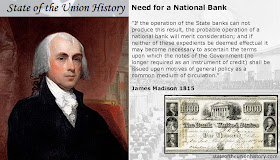"Although the embarrassments arising from the want of an uniform national currency have not been diminished since the adjournment of Congress, great satisfaction has been derived in contemplating the revival of the public credit and the efficiency of the public resources. The receipts into the Treasury from the various branches of revenue during the nine months ending on the 30th of September last have been estimated at $12.5M; the issues of Treasury notes of every denomination during the same period amounted to the sum of $14M, and there was also obtained upon loan during the same period a sum of $9M, of which the sum of $6M was subscribed in cash and the sum of $3M in Treasury notes."But the financial crisis was not over. The credit of the United States could no longer rest at the hands of the state banks. To address the situation, Secretary of Treasury Alexander J. Dallas worked hard to get a bill passed that would establish a new national bank, but Madison vetoed the proposed National Bank bill in January of 1815. Madison had been against a national bank since 1791, but now the country was in a fiscal mess, and he was having a change of heart. Madison was now urging Congress to once again consider the operation of a National Bank and the establishment of a uniform national currency. Madison had regretfully vetoed the first bill because it did not "answer the purposes of reviving the public credit, of providing a national medium of circulation, and of aiding the Treasury by facilitating the indispensable anticipations of the revenue and by affording to the public more durable loans." Thus, after 20 plus years of opposing a national bank, James Madison was finally giving in and giving Congress another chance to establish a National Bank. Alexander Hamilton was smiling in his grave.
"It is, however, essential to every modification of the finances that the benefits of an uniform national currency should be restored to the community. The absence of the precious metals will, it is believed, be a temporary evil, but until they can again be rendered the general medium of exchange it devolves on the wisdom of Congress to provide a substitute which shall equally engage the confidence and accommodate the wants of the citizens throughout the Union. If the operation of the State banks can not produce this result, the probable operation of a national bank will merit consideration; and if neither of these expedients be deemed effectual it may become necessary to ascertain the terms upon which the notes of the Government (no longer required as an instrument of credit) shall be issued upon motives of general policy as a common medium of circulation."The Second Bank of the United States was chartered into law on April 10, 1816 and officially began it's operations in Philadelphia on January 7, 1817. Shown in the picture above is a promissory note issued by the Second Bank of the Untied States in 1840.
http://www.presidency.ucsb.edu/ws/index.php?pid=29457
http://millercenter.org/president/madison/speeches/speech-3626
http://www.stateoftheunionhistory.com/2016/11/1814-james-madison-paying-for-war-of.html
https://en.wikipedia.org/wiki/Treasury_Note_(19th_century)
The War of 1812: A Forgotten Conflict, Bicentennial Edition, by Donald R. Hickey’s (University of Illinois Press) pg. 233
http://www.thegoldstandardnow.org/the-war-of-1812
http://www.wikiwand.com/en/Second_Bank_of_the_United_States

No comments:
Post a Comment